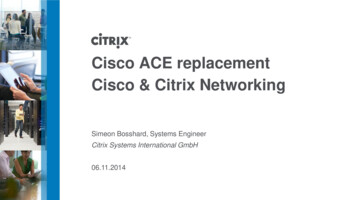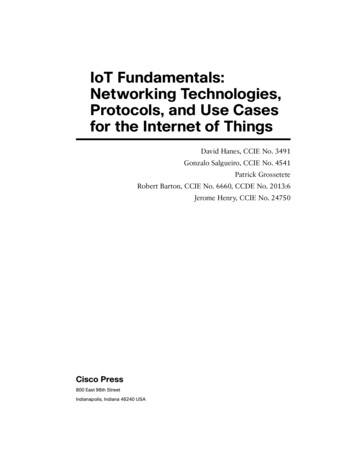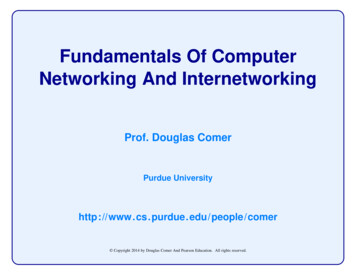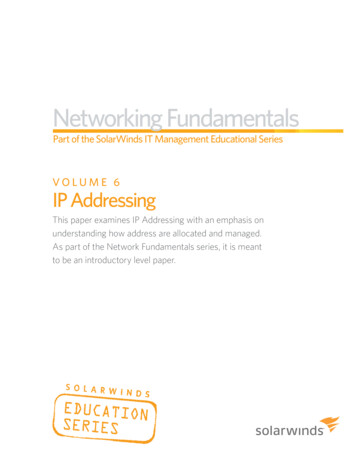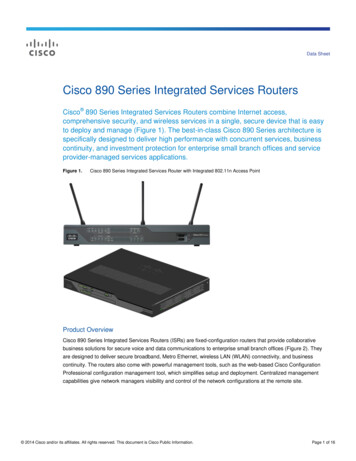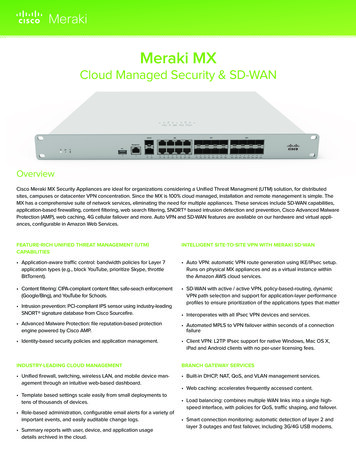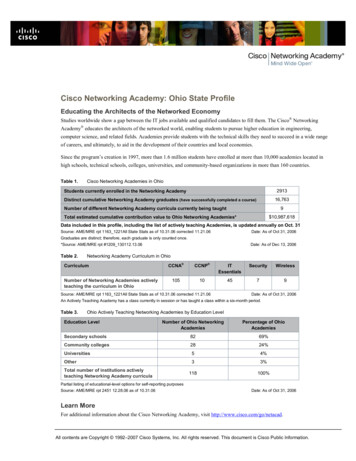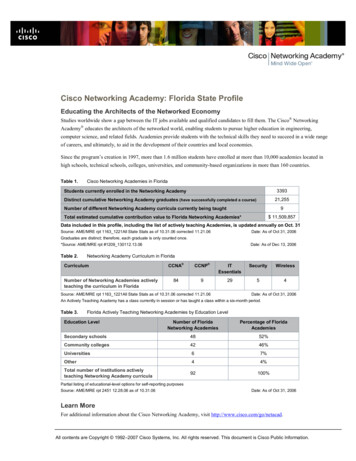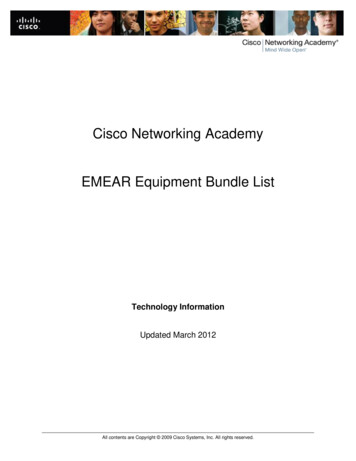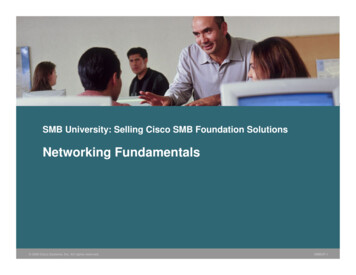
Transcription
SMB University: Selling Cisco SMB Foundation SolutionsNetworking Fundamentals 2006 Cisco Systems, Inc. All rights reserved.SMBUF-1
Objectives Describe the function and operation of a hub, a switch and arouter Describe the function and operation of a firewall and agateway Describe the function and operation of Layer 2 switching,Layer 3 switching, and routing Identify the layers of the OSI model Describe the functionality of LAN, MAN, and WAN networks Identify the possible media types for LAN and WANconnections 2006 Cisco Systems, Inc. All rights reserved.SMBUF-2
What is a Network? A network refers to two or more connected computers thatcan share resources such as data, a printer, an Internetconnection, applications, or a combination of theseresources. 2006 Cisco Systems, Inc. All rights reserved.SMBUF-3
Types of NetworksLocal Area Network (LAN)Metropolitan Area Network (MAN)Wide Area Network (WAN) 2006 Cisco Systems, Inc. All rights reserved.SMBUF-4
WAN TechnologiesLeased LineSynchronous serialCircuit-switchedTELEPHONECOMPANYAsynchronous serial. ISDN Layer 1 2006 Cisco Systems, Inc. All rights reserved.SMBUF-5
WAN Technologies (Cont.)Frame-RelaySynchronous serialSERVICEPROVIDERBroadband AccessSERVICEPROVIDERCable, DSL, Wireless WAN 2006 Cisco Systems, Inc. All rights reserved.SMBUF-6
Network Topologies: Bus TopologySEGMENTTerminator 2006 Cisco Systems, Inc. All rights reserved.TerminatorSMBUF-7
Network Topologies: Star TopologyHub 2006 Cisco Systems, Inc. All rights reserved.SMBUF-8
Network Topologies:Extended Star Topology 2006 Cisco Systems, Inc. All rights reserved.SMBUF-9
The OSI Model—Why a Layered Network Model?7654Application Reduces complexity Standardizes interfacesPresentationSession Facilitates modular engineering Ensures interoperable technology Accelerates evolutionTransport Simplifies teaching and learningNetwork3Data Link2Physical1 2006 Cisco Systems, Inc. All rights reserved.SMBUF-10
The Seven Layers of the OSI plication Layers (UpperLayers): Network Processes toApplications Data Representation InterHost CommunicationNetwork3Data Link2Physical1 2006 Cisco Systems, Inc. All rights reserved.SMBUF-11
The Seven Layers of the OSI Model nd To End Connections: Handles transportation issuesbetween hosts Ensures data transport reliability Establishes, maintains andterminates virtual circuits4Network Provides reliability through faultdetection and recovery3Data Link Information flow control2Physical1 2006 Cisco Systems, Inc. All rights reserved.SMBUF-12
The Seven Layers of the OSI Model (Cont.)765ApplicationPresentationSessionData Delivery: Provides connectivity and pathselection between two hostsystems Routes data packets4TransportNetwork3 Selects best path to deliver data The Network layer prioritizes dataknown as Quality of Service (QoS)Data Link2Physical1 2006 Cisco Systems, Inc. All rights reserved.SMBUF-13
The Seven Layers of the OSI Model (Cont.)76543ApplicationPresentationSessionAccess to Media: Defines how data is formatted fortransmission and how access tothe network is controlledTransportNetworkData Link2Physical1 2006 Cisco Systems, Inc. All rights reserved.SMBUF-14
The Seven Layers of the OSI Model inary Transmission: Defines the electrical, mechanical,procedural, and functionalspecifications for activating,maintaining, and deactivating thephysical link4Network3Data Link2Physical1 2006 Cisco Systems, Inc. All rights reserved.SMBUF-15
Physical Media TypesTwisted-PairTwisted-PairOuter jacketRJ-45ConnectorColor-Coded Plastic InsulationCoaxialOuter jacketBraided Copper ShieldingCopper ConductorBNCConnectorPlastic InsulationFiber OpticsOuter jacketKevlar Reinforcing MaterialGlass and Fiber CladdingSCConnector 2006 Cisco Systems, Inc. All rights reserved.Plastic ShieldSMBUF-16
Physical Media Types (Cont.)WirelessINTERNETETHERNET BACKBONE 2006 Cisco Systems, Inc. All rights reserved.SMBUF-17
Physical Media ComparisonTwisted PairBandwidthCoaxialUp to 1 Gbps 10–100 MbpsFiber OpticWirelessLANUp to10 Gbpsor higherUp to54 MbpsDistanceUp to 100 mUp to 500 mUp to 60 kmUp to 100 te 2006 Cisco Systems, Inc. All rights reserved.SMBUF-18
Hub or Repeater A hub (concentrator) is a device that repeats the signals itreceives on one port to all other ports. It is a centralconnection point for several network devices.Hub 2006 Cisco Systems, Inc. All rights reserved.SMBUF-19
Hub (Multiport Repeater) 2006 Cisco Systems, Inc. All rights reserved.SMBUF-20
Network Interface Card 2006 Cisco Systems, Inc. All rights reserved.SMBUF-21
WAN—Physical Layer Implementations Physical layer implementations vary Cable specifications define speed of linkCiscoHDLCPPPISDN BRI (withPPP)DSL Note: ISDN BRI cableNote: Workspinouts are different than over telephonethe pinouts for Ethernet. lineThe RJ-48 and RJ-45look the same, but thepinouts are different.X.21 V.24 V.35HSSI 2006 Cisco Systems, Inc. All rights reserved.FrameRelayNote: Worksover CableTV lineSMBUF-22
WANPhysical MediaWall Jack 2006 Cisco Systems, Inc. All rights reserved.SMBUF-23
Data Link Layer Data Link layer protocols create, transmit, and receivepackets. This layer is also responsible for logical MACaddressing and LLC processing, creating logical topologies,and controlling media access.Data Link2 2006 Cisco Systems, Inc. All rights reserved.SMBUF-24
MAC Address The network interface card address, called the hardwareaddress, is protocol-independent and is usually assigned atthe factory. This address is technically called the mediaaccess control address (MAC) because it is found on theMAC sub layer of the Data Link layer.Data Link00-0C-F1-5E-BE-F22MAC Address 2006 Cisco Systems, Inc. All rights reserved. Hardware AddressSMBUF-25
Data Link Devices The Data Link layer is manipulated by two devices: bridgesand switches. These are more complex and more expensivethan their Physical layer counterparts, but they do haveadvantages.Bridges 2006 Cisco Systems, Inc. All rights reserved.SwitchesSMBUF-26
Switch When a switch receives data the switch examines the datalink header for the MAC address of the destination stationand forwards it to the correct port. This opens a pathbetween ports that can use the full bandwidth of thetopology. 2006 Cisco Systems, Inc. All rights reserved.SMBUF-27
Network Layer The network layer provides connectivity and path selectionbetween two host systems that may be located ongeographically separated networksNetwork3 2006 Cisco Systems, Inc. All rights reserved.SMBUF-28
Network Layer (Cont.) IP is a standard that defines the manner in which the networklayers of two hosts interact. IP addresses are 32 bit long,hierarchical addressing scheme.Network192.168.6.173IP Address 2006 Cisco Systems, Inc. All rights reserved. Logical AddressSMBUF-29
Network Layer Devices The devices that operate at the Network layer are routers andLayer 3 SwitchesRouter 2006 Cisco Systems, Inc. All rights reserved.Layer 3 SwitchSMBUF-30
Routers Routers facilitate communication within this internet work. Itdecides how to send packets within the network so that theyarrive at their destination. 2006 Cisco Systems, Inc. All rights reserved.SMBUF-31
Layer 3 Switches The Layer 3 switch functions at the Network layer andperforms the multiport, virtual LAN, data pipelining functionsof a standard Layer 2 switch. It can also perform basicrouting functions between virtual LANs.Layer 3 Switch 2006 Cisco Systems, Inc. All rights reserved.SMBUF-32
Multilayer Switching765ApplicationPresentation Combines functionality of:– Layer 2 switching– Layer 3 switchingSession– Layer 4 switching High-speed scalabilityTransport4 Low latency compared to routersNetwork3Data Link2Physical1 2006 Cisco Systems, Inc. All rights reserved.SMBUF-33
Transport Layer Implementations The Transport layer is charge of the reliable/unreliabletransport of data. It can be implemented as TCP or UDP.TCP4 2006 Cisco Systems, Inc. All rights reserved.TransportUDPSMBUF-34
Gateway A gateway is a combination of hardware and software thatconnects dissimilar network environments. It performstranslations at multiple layers of the open systeminterconnection (OSI) model.OSI ModelGatewayPC Network 2006 Cisco Systems, Inc. All rights reserved.MAC NetworkSMBUF-35
Firewalls A firewall is a system or group of systems that managesaccess between two or more networksDMZNetworkINTERNETOutsideNetwork 2006 Cisco Systems, Inc. All rights reserved.InsideNetworkSMBUF-36
SummaryThis lesson covered the following main topics: The function and operation of a hub, a switch, and a router The function and operation of Layer 2 switching, Layer 3switching, and routing The OSI model Functionality of LAN, MAN and WAN networks Possible media types for LAN and WAN connections The function and definition of firewalls and gateways 2006 Cisco Systems, Inc. All rights reserved.SMBUF-37
2006 Cisco Systems, Inc. All rights reserved.SMBUF-38
The network interface card address, called the hardware address, is protocol-independent and is usually assigned at the factory. This address is technically called the media access control address (MAC) because it is found on the MAC sub layer of the Data Link layer. 2 Data Link MAC Address Hardware Address 00-0C-F1-5E-BE-F2
